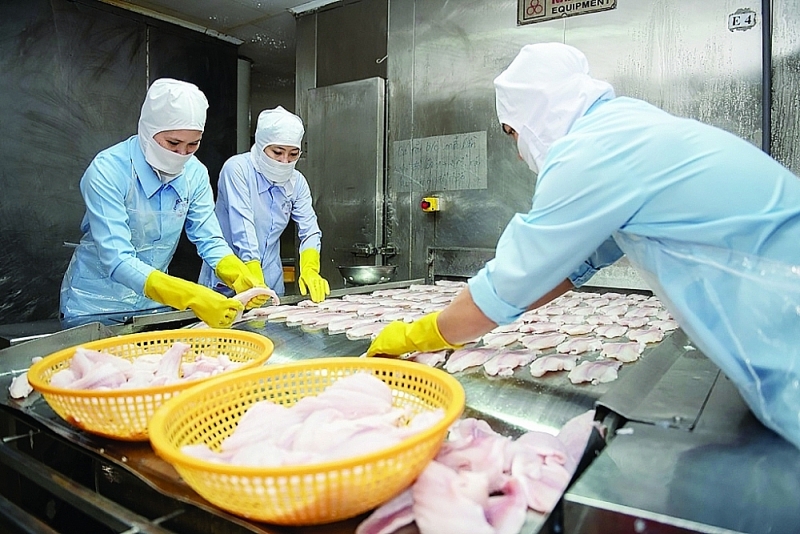 |
| Processing seafood for export at Fimex Vietnam Company. Photo: TL |
Agricultural and aquatic product granary of the whole country
According to the annual Mekong Delta Economic Report 2022 conducted by the Vietnam Confederation of Trade and Industry (VCCI) and a group of experts from the Fulbright School of Public Policy and Management, even though it accounts for only 7% of the country’s total export turnover, the Mekong Delta is the region that contributes the most to Vietnam’s trade surplus.
In 2020, the Mekong Delta had a trade surplus of US$9.4 billion, accounting for 47.4% of the country’s trade surplus. In 2021, the trade surplus was about US$8 billion, while the whole country had a trade surplus of US$4 billion, in the context of the complicated development of the Covid-19 pandemic, mainly because the main export products of the region are essential goods.
Currently, the increasing demand for food around the world is opening up great opportunities for the export of rice and seafood in the Mekong Delta. However, the paradox is that the Mekong Delta is the area with the highest logistics costs, accounting for 30% of product costs.
Data from the Mekong Delta Annual Economic Report shows that it takes from VND5.5 to 6 million to transport a container by road from Can Tho to the ports in District 7 (HCMC), if going to Cat Lai port. the cost is VND6-6.5 million and to Cai Mep is VND8.5-9 million.
For waterways, which are considered a unique and strong form of transportation in the Mekong Delta, transportation is not easy.
Accordingly, although the cost of transportation is low compared to road transport, at VND3.5 – 5 million per container when going to ports in Ho Chi Minh City and about VND4 – 5.5 million when going to Cai Mep, the transportation time is still much longer.
Specifically, it takes up to 20-24 hours for a barge to go from Can Tho to the ports of Ho Chi Minh City, while by road it only takes 5-6 hours, to Cai Mep port is 36-40 hours by waterways, while by road is 8-8.5 hours.
With such a long time, the costs of cold storage, preservation, and loss costs are huge. Therefore, time-sensitive items can only be transported by road. In addition, the system of connecting waterways with roads is still limited, due to limited channels, ships with a tonnage of more than 10,000 tons cannot directly enter ports in the region.
Therefore, enterprises still have to trans-ship goods and take empty containers through the Ho Chi Minh City area, so logistics costs increase. This is also the reason for the traffic congestion and overcrowding that occurs frequently on the roads connecting Ho Chi Minh City to the provinces in the Mekong Delta.
In addition, all the basic logistics infrastructure of this area is also very sparse, lacking a key logistics centre, satellite systems, warehouse systems, sanitary inspection and standard irradiation; no empty depots yet.
Investing in traffic systems and seaports
Faced with major shortcomings that are hindering the development of exports in the Mekong Delta, recently, the Prime Minister issued Decision 287/QD-TTg on “Approval of the Master Plan for the Mekong Delta in 2021 – 2030, vision to 2050”.
According to Mr. Nguyen Thanh Phong, Deputy Head of the Central Economic Commission, the Mekong Delta was identified as the largest agricultural production centre in the country. Decision 287/QD-TTg approving the Master Plan for the Mekong Delta had set the goal of developing the Mekong Delta by 2030 into a sustainable, dynamic and highly efficient agricultural economic centre of the country, the region and the world.
Accordingly, the Government will invest in new construction and upgrading of about 830km of highways, approximately 4,000km of national highways, four airports, 13 seaports, 11 clusters of passenger ports and 13 clusters of inland waterway cargo ports.
Along with the Ho Chi Minh City – Trung Luong expressway with 50km long from Ho Chi Minh City through Long An to Tien Giang and the expressway connecting Trung Luong – My Thuan being put into operation, this project when completed promises to open up great potential to develop logistics services for the Mekong Delta provinces.
According to Mr. Nguyen Phuong Lam, Director of VCCI Can Tho, it is expected that in the next 3-5 years, there would be a smooth highway from Ho Chi Minh City to Can Tho, Ca Mau, Chau Doc (An Giang), along with that, Dinh An channel would dredged, the Centre for the association of production, processing and consumption of agricultural products in the Mekong Delta would be formed.
“It will be the second “golden opportunity” for the Mekong Delta in the past two decades, especially for the logistics and seaport industry to make a breakthrough,” said Mr. Lam.
 | Agricultural sector seeking ways to boost exports Minister of Agriculture and Rural Development (MARD) Le Minh Hoan has suggested building an export market development … |
The Mekong Delta will also be promoted connection through a system of eight airports, namely Tan Son Nhat, Can Tho, Phu Quoc, Buon Ma Thuot, Lien Khuong, Rach Gia, Con Dao and Ca Mau. This airport system not only helps to fulfill the logistics system for the Mekong Delta but also helps promote tourism for the region, thereby supporting the development of the consumption of regional products.
